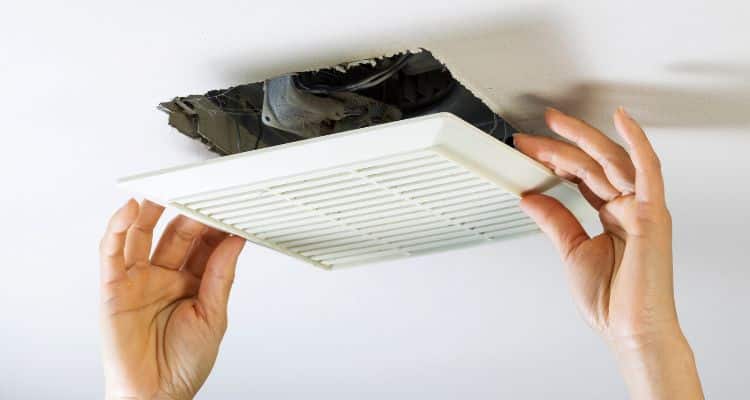
When considering the air quality in a bathroom, proper ventilation is vital.
A fan’s CFM measures the air it can move in one minute, effectively removing humidity and odors. A bathroom exhaust fan with the right CFM is critical for maintaining a fresh environment and preventing mold growth.
Calculating the best CFM for a bathroom exhaust fan involves considering its size and layout. Standard recommendations suggest 1 CFM per square foot of bathroom area as a starting point.
However, when a bathroom has more fixtures, such as a shower or a higher bathroom ceiling, the CFM must be increased to accommodate the additional room and moisture.
What Is CFM And How Does It Relate To Bathroom Size?
CFM stands for Cubic Feet per Minute, the measurement unit used to gauge the amount of air a bathroom fan can move. This measurement is vital in determining the correct fan size for a bathroom’s ventilation.
Essentially, the CFM tells you how powerful the fan needs to be to effectively replace the air in a bathroom, keeping it fresh and free from excess humidity, mold, mildew, and odors.
Understanding the size and volume of a bathroom will help you calculate the number of air changes per hour necessary to maintain a healthy environment. The standard bathroom recommendation is for a fan to achieve at least 8 air changes per hour.
Here’s a simple way to relate CFM to bathroom size:
- Calculate the volume of your bathroom by multiplying the length, width, and height.
- Determine the required air changes per hour. Bathrooms typically need at least 8 air changes.
- Multiply the volume by the number of air changes per hour. Then, divide by 60 to get the required CFM.
It’s also important to consider additional factors like the presence of a shower, tub, or bath, as these can increase the humidity levels and require a more powerful fan.
How Do I Calculate CFM For a Bathroom Exhaust Fan?

In general, the size and fixtures in the bathroom must be considered to determine the correct CFM for a bathroom exhaust fan. Here is how to calculate CFM correctly for different bathroom types and sizes.
Standard Bathroom
Calculating the CFM is relatively straightforward for standard-sized bathrooms. The rule of thumb is to allocate at least 1 CFM per square foot (length x width) of bathroom area.
For example, if your bathroom measures 5 feet by 8 feet, you would need a fan rated for at least:
5ft x 8ft = 40 CFM
However, this is an absolute minimum, and installing slightly more powerful bathroom exhaust fans is undoubtedly better. In this case, a 50 CFM bathroom ventilation fan would be ideal.
Large Bathrooms
For large bathrooms defined as 10 feet by 10 feet or larger, it is advisable to determine the CFM based on the number of plumbing fixtures present instead of the overall floor area. Allocate 50 CFM for each standard fixture, such as toilets or showers, and more substantial fixtures, such as jacuzzi, allocate 100 CFM.
So, a 100 CFM vent fan unit is the minimum for a bathroom with just a toilet and shower.
Bathrooms With High Ceilings
Standard CFM calculation must be adjusted for high ceilings to factor in the higher vertical space. Here’s the formula that takes ceiling height into account:
CFM = Length x Width x Height ÷ 60
You can also include air changes per hour (ACH) in your calculation for optimal effectiveness. A standard guideline is to ensure 8 ACH. Here is the updated formula:
CFM = Length x Width x Height x ACH ÷ 60
For example, a 7×9 bathroom with a ceiling height of 10 feet and an ACH of 8 will need:
7ft x 9ft x 10ft x 8 ÷ 60 CFM = 84 CFM
In this case, you’ll need the right exhaust fan with a CFM of at least 84, ensuring sufficient air circulation for a bathroom with high ceilings. However, oversizing it to 90 or even 100 could also be a good idea.
Based on the formula above, please use this calculator to calculate CFM for your bathroom.
When May I Need A Secondary Bathroom Fan?
Suppose your bathroom has multiple large fixtures, such as jetted tubs or jacuzzis. In that case, these can significantly increase the moisture levels in the space due to the greater volume of water and moisture they produce.
Furthermore, if the bathroom itself is large enough, the existing vent fan may not be sufficient to circulate air and effectively remove excess humidity. In such cases, an additional exhaust fan may be needed to ensure it can handle the increased demand.
Lastly, some bathroom layouts may prevent a single bathroom fan from providing sufficient ventilation. If parts of the bathroom frequently have excess moisture, you might consider a new exhaust fan for those areas.
Is It Possible To Oversize A Bathroom Fan?

It’s common to think that bigger means better, but that’s not always the case with bathroom ventilation. If you choose a fan with a higher CFM than necessary, it could result in several issues:
- Noise: Fans with higher CFM ratings tend to produce more noise. The sound a fan makes is measured in sones. More sones mean a louder fan, which can be intrusive.
- Negative Pressure: An oversized fan might create negative pressure in my home, drawing unwanted outdoor air into other house areas.
- Energy Efficiency: Using an oversized fan can increase energy use. For better efficiency, stick to an Energy Star-rated fan.
How Does Higher CFM Relate To Additional Noise?
When selecting a bathroom fan, higher CFM ratings often come with increased noise, but it’s not just a question of more power, more noise. A Noise level is measured in sones and indicates how loud a fan will sound to the average listener.
As CFM increases, fan blades rotate faster, and the fan motor works harder, which can lead to a rise in noise. However, that’s not a set rule. A well-designed high-CFM fan can be as quiet as a lower-CFM model.
Pay attention to the same rating when looking for a quiet fan. One sone is roughly equivalent to the sound of a quiet refrigerator in a quiet kitchen.
Here is an example of CFM correlation for most exhaust fans with the noise they produce:
- 50 CFM 0.5 – 1.5 Sones
- 80 CFM 0.5 – 2.5 Sones
- 110+ CFM 1 – 4 Sones
Additionally, technological improvements mean that a fan with a high CFM can be engineered to minimize noise. Features such as multiple fan speeds and sound-dampening materials help moderate sound levels.
How Many Sones Is A Quiet Bathroom Fan?
As for bathroom fans, I consider anything at or below 2 sones fairly quiet. Typically, you can tell a fan is on, but it doesn’t cause disruption.
A fan that operates at 1 sone or lower enters the whisper-quiet territory. It produces a noise level that’s quite soft, making it hardly noticeable, especially during daily activities.
When selecting a quiet bathroom exhaust fan, pay close attention to these numbers. However, don’t forget that functionality shouldn’t be compromised for quietness. Your bathroom fan should still effectively ventilate the space, typically measured in cubic feet per minute (CFM).
Frequently Asked Questions
Is there a risk in installing a bathroom exhaust fan with a CFM rating that is too high?
Yes, there is a risk. Proper ventilation is crucial, but installing an exhaust fan with a CFM rating that’s too high for your bathroom’s size can be problematic. It can create negative pressure, leading to hazardous backdrafts from fireplaces or furnaces. An overly powerful fan can also cause excess noise and increased energy consumption.
It’s important to size your bathroom fan correctly to maintain indoor air quality and safety.
Daniel Barczak
Daniel Barczak is a software developer with a solid 9-year track record in the industry. Outside the office, Daniel is passionate about home automation. He dedicates his free time to tinkering with the latest smart home technologies and engaging in DIY projects that enhance and automate the functionality of living spaces, reflecting his enthusiasm and passion for smart home solutions.


Leave a Reply